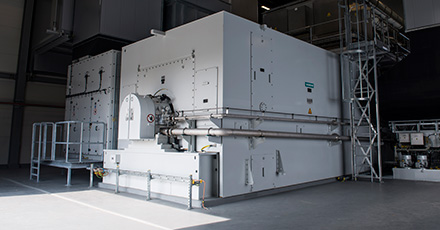In the infancy of the electricity grid, there was a need for systems capable of maintaining a stable voltage level and for the availability of additional power in the event of short circuits. Now, the need has reoccurred as an increasing share of electricity is produced by wind turbines. Therefore,
Siemens has reinvented the technology.
After enjoying their glory days, many smart devices fade into oblivion. But now, one of them is making a comeback—the so-called synchronous compensator.
“We’ve reinvented the synchronous compensators. In Denmark and also in a number of other European countries, renewable energy shares are high. At the same time, major central power stations are being mothballed. This means we lack electricity system stabilizers, which makes compensators relevant once again,” says Peter Weinreich-Jensen, Account Manager at Siemens Denmark.
The company has so far delivered four compensators in Europe and two in the USA, and a number of projects are in the pipeline. The two American compensators are located in southern California, where the use of solar power is widespread, and the production varies significantly for obvious reasons.
When the compensators were discarded
"The operators report that they can more easily control the voltage level. Previously, they constantly had to connect and disconnect the equipment, but now the system adjusts itself."
Peter Weinreich-Jensen, Account Manager at Siemens Danmark.
A synchronous compensator takes up a lot of space. Siemens’ version is 10 metres high and located in a building measuring 30 metres by 30 metres. The principle is similar to an electrically powered generator. Unlike a generator, however, the shaft of the device is not connected to a turbine, but rotates freely. The device is designed to counteract minor fluctuations in the electricity grid’s voltage. The word synchronous refers to the fact that the speed of rotation of the compensator shaft corresponds to the frequency of the electricity grid. In Denmark, where the standard frequency is 50 Hz, this equates to 3,000 revolutions per minute. In the event of a slight decrease or increase in the voltage level of the grid, the device itself will counteract the change. This occurs within the space of milliseconds.
In the infancy of the electricity system, power station generators were exclusively supported by synchronous compensators in maintaining the appropriate voltage level in the grid. Since then, however, considerable progress has been achieved in the field of so-called power electronics, which refers to the conversion of electric power. Power electronic devices of the type SVC, Static WAS Compensator, turned out to be a smarter way of maintaining the voltage level. Even though a synchronous compensator is optimized to have a minimal friction, it is not possible to completely avoid internal energy losses in the device. An SVC, however, results in significantly reduced losses.
That was the reason why synchronous compensators were phased out, which happened gradually from the 1960s onwards.
Flashing lights
Nevertheless, power electronics cannot replace another role previously played by synchronous compensators: to correct the frequent short circuits in the electricity system. A large bird flies into some power lines, or a tree falls into a power pole. As a consumer, you typically see a flash of light. To limit the consequences, the system must contain a sufficient reserve of so-called reactive power.
“A short circuit involves a sudden, major release of energy which is easily identifiable, so the defective line or component can be disconnected and normal operation can be quickly restored. This happens automatically. Nevertheless, you need power during the short period of milliseconds or perhaps seconds it takes for the system to perform the actions,” explains Peter Weinreich-Jensen.
“The standard compensation in the grid is to connect capacitor batteries. This goes well as long as there’s still an overall reactive system. In the event of surplus power, the system becomes self-oscillating (fluctuating, ed.). Here, a synchronous compensator can return the reactive characteristic to the system without active regulation. This is not possible with a system based on SVC power electronics.”
Power stations stabilized the system
The reason synchronous compensators were discarded was, nevertheless, that the need for reactive power was covered by the large central power stations where the system could easily be fed with excessive additional power. But now that power stations are being decommissioned or disconnected for longer periods of time, it means that their short-circuit power is not available. For example, the entire power supply on Zealand during summer can be covered by wind power supplemented by imported power, but short-circuit power is unavailable. In this case, it is much cheaper to have two or three synchronous compensators running, rather than a power station with the sole purpose of supplying reactive power.
DTU simulates control
As a growing number of countries are investing in renewable energy sources, Siemens sees a bright future for synchronous compensators. While the company has resumed the production of the devices, Siemens Denmark has initiated a research partnership with the Center for Electric Power and Energy at DTU Electrical Engineering. The partnership project is entitled ‘SCAPP’ (Synchronous Condensers APPlication in Low Inertia Systems).
“We’re proud of the fact that Siemens has chosen us as their academic partner for the development of synchronous compensators,” says Associate Professor Guangya Yang, who is the head of the ‘SCAPP’ project at DTU.
”We specialize in systems for control of the devices. We also look at where the condensers are to be placed in a given electricity system to ensure maximum benefit.”
The DTU researchers simulate alternative solutions to the integration of synchronous compensators in the PowerLab laboratory.
“In the PowerLab, we can simulate power throughout electricity system. It’s an important test of whether the ideas for improving the compensators and their control are feasible,” says Peter Weinreich-Jensen, Siemens Denmark.

The reinvented synchronous compensator measures 10 metres by 10 metres and is designed to ensure that the electricity system remains stable despite fluctuations in the wind and solar power production.